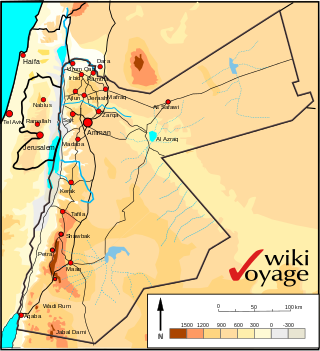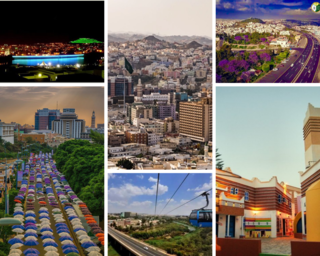
Jordan is situated geographically in West Asia, south of Syria, west of Iraq, northwest of Saudi Arabia, east of Palestine. The area is also referred to as the Middle or Near East. The territory of Jordan now covers about 91,880 square kilometres (35,480 sq mi).

The United Arab Emirates is situated in the Middle East and West Asia, bordering the Gulf of Oman and the Persian Gulf, between Oman and Saudi Arabia; it is at a strategic location along the northern approaches to the Strait of Hormuz, a vital transit point for world crude oil. The UAE lies between 22°50′ and 26° north latitude and between 51° and 56°25′ east longitude. It shares a 19 km (12 mi) border with Qatar on the northwest, a 530 km (330 mi) border with Saudi Arabia on the west, south, and southeast, and a 450 km (280 mi) border with Oman on the southeast and northeast.

Yemen is located in West Asia, at the southern tip of the Arabian Peninsula, between Oman and Saudi Arabia. It is situated at the entrance to the Bab-el-Mandeb Strait, which links the Red Sea to the Indian Ocean and is one of the most active and strategic shipping lanes in the world. Yemen has an area of 555,000 square kilometres (214,000 sq mi), including the islands of Perim at the southern end of the Red Sea and Socotra at the entrance to the Gulf of Aden. Yemen's land boundaries total 1,746 kilometres (1,085 mi). Yemen borders Saudi Arabia to the north and Oman to the northeast. Through the Socotra island, Yemen also shares borders with the Guardafui Channel and the Somali Sea.

The Arabian Desert is a vast desert wilderness in West Asia that occupies almost the entire Arabian Peninsula with an area of 2,330,000 square kilometers (900,000 sq mi). It stretches from Yemen to the Persian Gulf and Oman to Jordan and Iraq. It is the fifth largest desert in the world and the largest in Asia. At its center is Ar-Rub' al-Khali, one of the largest continuous bodies of sand in the world. It is an extension of the Sahara Desert.

Jizan Region also spelled Jazan is the second smallest region of Saudi Arabia. It stretches 300 km (190 mi) along the southern Red Sea coast, just north of Yemen. It covers an area of 11,671 km2 and had a population of 1,404,997 at the 2022 census. The region has the highest population density in the Kingdom. The capital is the city of Jazan; Prince Muhammad bin Nasser has been the Governor since April 2001.

Dammam is the fourth-most populous city in Saudi Arabia after Riyadh, Jeddah, and Mecca. It's the capital of the Eastern Province, with a total population of 1,532,300 as of 2022. The judicial and administrative bodies of the province, in addition to the administrative offices of other minor governmental departments functioning within the province, are located in the city. The word itself is generally used to refer to the city, but may also refer to its eponymous governorate.

Khobar is a city and governorate in the Eastern Province of the Kingdom of Saudi Arabia, situated on the coast of the Persian Gulf. With a population of 457,748 as of 2017, Khobar is part of the 'Triplet Cities' area, or Dammam metropolitan area along with Dammam and Dhahran, forming the residential core of the region.

Jizan, also spelled Jazan, Gizan or Gazan, is a port city and the capital of Jizan Region, which lies in the southwest corner of Saudi Arabia. Jizan City is situated on the coast of the Red Sea and serves a large agricultural heartland that has a population of 319,119 as of 2021 and over 1.5 million, within metropolitan area. As the city is the capital of the region, it has the regional airport as well as the Jizan seaport. The area is noted for its high-quality production of fruits such as mangoes, figs, papayas, plum and coffee.

Abha is the capital of 'Asir Region in Saudi Arabia. It is situated 2,270 metres above sea level in the fertile Asir Mountains of south-western Saudi Arabia, near Asir National Park. Abha's mild climate makes it a popular tourist destination for Saudis. Saudis also call the city the Bride of Mountain due to its position above the sea.

Badr is a town in Al Madinah Province, Al-Hijaz, Saudi Arabia. It is located about 130 km (81 mi) from the Islamic holy city of Medina. It was the location of the Battle of Badr, between the Quraishi-led polytheists, and the Muslims under the leadership of Muhammad, in 624 CE.

Duba is a small city on the northern Red Sea coast, of Saudi Arabia. It is in Tabuk Province. Local citizens describe it as The Pearl of the Red Sea. The population of Duba is about 22,000.
Rafha is a town in the north of Saudi Arabia, close to the border with Iraq. It is located at around 29°38′19″N43°30′5″E. Rafha had a population of 80,544 at the 2010 Census. After Arar, it is the second largest city in the Northern Borders Region. Currently the Ministry of Housing is building over 600 new villas for the local population and others and making significant improvements to the local infrastructure.

Dhahran is a city located in the Eastern Province, Saudi Arabia. With a total population of 240,742 as of 2021, it is a major administrative center for the Saudi oil industry. Together with the nearby cities of Dammam and Khobar, Dhahran forms part of the Dammam Metropolitan Area, which is commonly known as greater Dammam and has an estimated population of 4,140,000 as of 2012.

Ḥaql or Ḥaqal is a city in the northwest of Saudi Arabia near the head of the Gulf of Aqaba, adjacent to Aqaba across the Jordanian border. The coasts of Egypt, Israel, and Jordan can be seen from Haql.

Hafar al-Batin, also frequently spelled Hafr al-Batin, is a city in the Hafar al-Batin Governorate, Eastern Province, Saudi Arabia. It is located 430 km north of Riyadh, 94.2 km from the Kuwait border, and about 74.3 from the Iraq border. The city lies in the dry valley of the Wadi al-Batin, which is part of the longer valley of the river Wadi al-Rummah, which leads inland toward Medina and formerly emptied into the Persian Gulf.

Sakākā is a city in northwestern Saudi Arabia which is the capital of Al Jawf Province. It is located just to the north of the An Nafud desert. Sakakah had a population of 242,813 at the 2010 census.

Arar is the capital of Northern Borders Province in Saudi Arabia. It has a population of 145,237.
Rugby union in Saudi Arabia is a minor but growing sport, which has been played for several decades in the Kingdom of Saudi Arabia. Many of the local rugby union teams date back to the late 1970s.
At Turqi is a village in Makkah Province, in western Saudi Arabia.
The desert-covered Kingdom of Saudi Arabia is the geographically largest country in the Middle East. Moreover, it accounts for 65% of the overall population of the GCC countries and 42% of its GDP. Saudi Arabia does not have a strong history in environmentalism. Thus, as the number of population increases and the industrial activity grows, environmental issues pose a real challenge to the country.

















